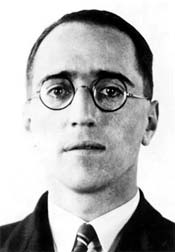|
 In
1923 Alan Blumlein was awarded a BSc (first class
honours) in electrical technology from City and Guilds
College (part of Imperial College). In 1924 he
started work on telecommunications for International
Western Electric which later became Standard Telephones
and Cables. In
1923 Alan Blumlein was awarded a BSc (first class
honours) in electrical technology from City and Guilds
College (part of Imperial College). In 1924 he
started work on telecommunications for International
Western Electric which later became Standard Telephones
and Cables. In 1929 he moved to work for the Columbia
Gramophone Company (which later merged to become EMI). It was while he
was working here that he came up with the idea of what he called 'binaural
sound' - the beginning of what we now call stereo. His name is preserved
in the term 'Blumlein pair' which is used to describe a configuration of two
microphones to record stereo sound (two microphones in one place pointing
at right angles to each other). Later in the 1930s Blumlein played a
pioneering role in the development of the BBC's television transmission
service based at Alexandra Palace. Although EMI was not made aware of the
radar development programme as war approached, Alan Blumlein did propose use
of binaural sound to improve on the detection of aircraft by sound. Soon
after the start of the war, EMI and Alan Blumlein did become involved in the
development of Airborne Radar. Alan was still with EMI when he
started work on H2S airborne radar with other colleagues from EMI and Bernard
Lovell amongst others. In June 1942 he died tragically when
a Halifax bomber crashed at near Goodrich while testing the prototype of the H2S
radar. For more information - see the links below.
Alan Dower Blumlein
29 June 1903 - 7 June 1942
|